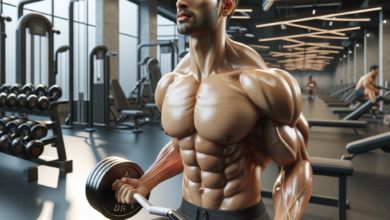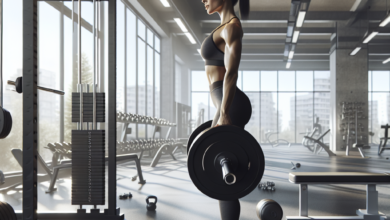High Bar vs. Low Bar Squats: Learn What’s Best For You

Squats are one of the primary muscle-building workouts used in gyms around the world every day. The number of squat variations you can do seems endless, with each variation carrying its own unique attributes that can contribute to optimal muscle growth.
In this article, we’ll focus on two different squat workouts that have the potential to seriously up your fitness game: low-bar squats and high-bar squats. While these two squat variations are similar, they can help in different ways when implemented into your weight training routine. Below, we’ll look at the differences between the two squat exercises and identify key ways to amplify your current workouts.
What Are Squats and How Can They Benefit You?
Squats are considered compound exercises because they engage a large group of muscles in a single workout. Basic squats are conducted by standing straight with your feet hip-width apart and slowly lowering your hips until your knees and thighs are parallel to the ground.
When you conduct a basic squat, the following upper-body, lower-body, and core muscles are generally worked:
- Calf muscles
- Adductor muscles
- Quadriceps
- Hamstrings
- Gluteus maximus
- Hip flexor muscles
- Obliques
- Erector spinae
- Rectus abdominus
- Transverse abdominus
Not only are squats excellent for working the muscles listed above, but they can also provide essential benefits to those who implement them in their regular exercise routines. Some of the most common squat benefits can include:
- Athletics – By strengthening and toning the muscle groups listed above, you can experience enhanced athletic strength, stamina, and ability.
- Posture – When you work to strengthen muscles and balance yourself during workouts, you can often see an improvement in overall posture.
- Injury Reduction – Because your muscle strength is improving, and because squats require a certain amount of coordination and mobility, you can reduce your risk of sustaining an injury while performing other exercises and daily movements.
- Daily Tasks – Improvement of daily task performance, such as walking, running, stair climbing, lifting, and more can be achieved.
- Stamina – Over time and with practice, squats can help you build more stamina in carrying out movements related to the exercise.
- Calorie Burning – Compound workouts such as squats have a good reputation for enabling high calorie and fat burning levels. According to one study, 30 minutes of vigorous weightlifting can burn up to 266 calories with someone who weighs 185 pounds.
- Core Strengthening – The muscles in your body’s core area make general movements like standing, walking, running, and bending over possible. Through exercises like squats, your core muscles can get a very high-impact workout.
What Are High-Bar and Low-Bar Squats?
High-bar and low-bar squats are two popular variations of squats that are used to place greater emphasis on specific muscle areas. Here’s how to perform both of these squat variations:

High-Bar Squats
- Stand straight with your feet placed shoulder-width apart.
- Using a weighted barbell, place it across the top of your shoulders and behind your neck while grasping each side with an overhanded grip.
- Keeping the bar and your back straight, lower your hips until they are parallel to the ground.
- Return to the standing position to complete the rep.
- Repeat for a predetermined amount of reps.

Low-Bar Squats
- Stand straight with your feet placed shoulder-width apart.
- Using a weighted barbell, place it across the lower portion of your upper back while grasping each side with an overhanded grip.
- Keeping the bar and your back straight, lower your hips until they are parallel to the ground.
- Return to the standing position to complete the rep.
- Repeat for a predetermined amount of reps.
Benefits of High-Bar Squats vs. Low-Bar Squats
So why would you choose to perform high-bar squats as opposed to low-bar squats? Or should you use some combination of both squat variations? How and if you engage in performing either squat depends on your fitness goals and which muscle groups you’re looking to work out. Below is a breakdown of the individual benefits you can get from either squat variation:
High-Bar Squat Benefits
- Low Impact – High-bar squats can make for an excellent choice for those who have lower back pain or injuries. This variation of squats is a lower impact on the lower back area, thus making the squat move easier to perform and stay balanced during.
- Quadricep Strength – Because of the bar’s position during this squat exercise, your quadricep muscles are used in full-force. Essentially, if you’re looking to build muscle and strength in the front of your thigh area, high-bar squats are the move for you.
Low-Bar Squat Benefits
- Glutes and Hamstrings – Your posterior muscle groups are primarily focused on during low-bar squat reps. With the placement of the bar being lower, it places more strain on your glutes and hamstrings to give them a great workout.
- Ankle Support – Those who have ankle injuries or less strength in that area might be better suited to performing low-bar squats. Low-bar squats do not require as much angle of flexion, thus reducing the amount of mobility that’s required of your ankles during the exercise.
Is One Better Than the Other?
Because each squat variation’s individual muscle benefits are different, one can’t be technically stated as better than the other. However, this statement isn’t to say that the low-bar squat might be better suited for you than the high-bar squat. Depending on your current workout goals and any applicable mobility restrictions as listed above, you may gain more benefit from using one over the other.

Alternative Squats to Try
If you’re looking for some other squat variations to try that focus on the same key muscle groups as the high-bar and low-bar squats, we’ve listed some popular ones to consider below:
- Goblet Squat – In this squat variation, you’ll maintain the same form as the high-bar and low-bar squats, but instead, hold a kettlebell in front of your chest with your elbows bent. While continuing to hold the kettlebell, squat down until your hips are parallel to the floor, and then stand up to complete the repetition. This squat variation is excellent for building your quadricep area.
- Front Squat – In the front squat variation, you’ll hold a weighted bar in front of you just above your shoulders while keeping your feet shoulder-length apart. Cross your arms and hold the bar in its center to balance, then squat until your hips are parallel to the floor. Return to the standing position to complete the repetition. Use this squat variation to build quadricep muscles.
- Dumbbell Squat to Press – During this variation, stand with both feet shoulder-length apart while holding a dumbbell in each hand. Bend your elbows and hold each dumbbell just above your shoulder area. You’ll then proceed to squat until your hips are parallel to the floor, before returning to the standing position to complete your repetition. This move helps to build your glute muscles.



